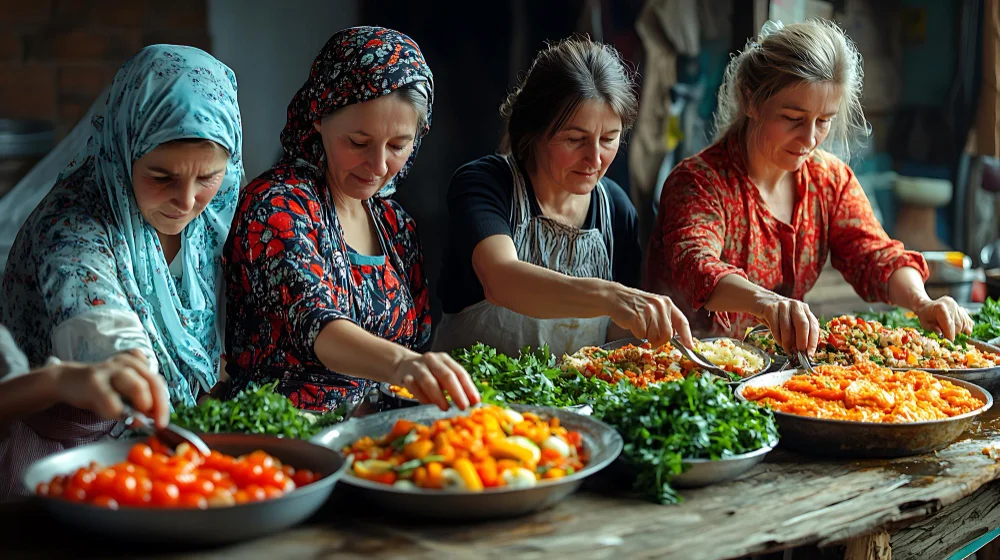Çeciir, a dish synonymous with Turkish culture and hospitality, represents more than just a meal; it is a symbol of rich culinary history, community bonds, and sustainable farming practices. Made primarily from chickpeas, this traditional dish has traveled through generations, offering a unique blend of flavors, culture, and health benefits. This article will explore the historical significance, preparation methods, cultural importance, regional variations, modern adaptations, and nutritional benefits of Çeciir, showing how this humble dish continues to evolve and thrive in contemporary kitchens around the world.
Introduction to Çeciir
Çeciir has been a cornerstone of Turkish cuisine for centuries. With its deep roots in Turkish history, this dish is much more than a meal—it’s a reflection of the country’s cultural traditions and agricultural practices. While chickpeas serve as the main ingredient, Çeciir has evolved through time, embracing regional flavors and seasonal ingredients, making it a beloved dish for families and communities across Turkey. Whether served at a bustling street stall in Istanbul or in the comfort of a family home, Çeciir embodies the warmth of Turkish hospitality and the spirit of togetherness.
In this article, we will delve into the origins of Çeciir, its traditional preparation, the role it plays in Turkish culture, and how it has found new life in modern cuisine. We’ll also look at the dish’s nutritional benefits and its growing importance in sustainable food systems.
The Historical Significance of Çeciir
Çeciir’s history is intertwined with the agricultural development of Turkey. Chickpeas, the primary ingredient in Çeciir, have been cultivated in the region for thousands of years, with archaeological evidence indicating their presence in ancient Anatolian civilizations. These early societies valued chickpeas for their nutritional benefits and versatility, and over time, the humble legume became a staple in Turkish kitchens.
The word “çeciir” itself carries historical significance. It’s believed to have originated from the Turkish language, where the term “çeci” refers to the simplicity and purity of the chickpea. This connection between the dish and its main ingredient highlights the enduring relationship between food and culture in Turkey.
Throughout history, Çeciir was often considered a peasant’s dish, affordable and nourishing for large families. However, its enduring popularity reflects the resilience of Turkish culinary traditions, where dishes once considered simple staples are now cherished elements of the nation’s gastronomy.
Evolution of Çeciir: From Ancient to Modern Times
Over the centuries, Çeciir has undergone numerous transformations. What started as a straightforward, rustic dish has evolved into a more sophisticated culinary creation enjoyed by people of all walks of life. As regional influences shaped Turkish cuisine, Çeciir adapted to suit local ingredients and tastes.
In the Ottoman Empire, where a rich tapestry of culinary traditions was forged, Çeciir began to appear in more formal settings. The dish’s versatility allowed it to evolve from a humble stew to a more elaborate creation, featuring different meats, vegetables, and spices depending on the region. By the time the dish spread across the country, it had adapted to reflect the diverse food cultures in each area.
Today, Çeciir is enjoyed not only in traditional Turkish meals but also in modern variations that incorporate international influences. From street vendors in Istanbul to high-end restaurants in Ankara, Çeciir has evolved into a symbol of both traditional Turkish hospitality and contemporary innovation.
Traditional Preparation of Çeciir
One of the most appealing aspects of Çeciir is its simplicity. The preparation of this dish involves a few basic ingredients, but the key lies in the careful cooking process. Traditionally, Çeciir begins by soaking dried chickpeas overnight. This step softens the beans and shortens the cooking time, making the dish both practical and flavorful.
Ingredients:
- Dried chickpeas
- Onions
- Garlic
- Tomato paste
- Olive oil
- Vegetable or chicken broth
- Spices: cumin, red pepper flakes, oregano, bay leaves
- Fresh parsley and lemon for garnish
Instructions:
- Soak the chickpeas overnight to soften them.
- Drain the chickpeas and add them to a large pot with chopped onions, garlic, tomato paste, and olive oil.
- Pour in the vegetable or chicken broth, and stir in the spices (cumin, red pepper flakes, oregano, and bay leaves).
- Let the mixture simmer on low heat until the chickpeas are tender and the sauce thickens.
- Serve warm, garnished with fresh parsley and a squeeze of lemon juice.
This method of preparation results in a rich, fragrant stew perfect for pairing with rice or fresh bread. The combination of spices and olive oil creates a warm, comforting dish that brings together the rustic and refined elements of Turkish cuisine.
Regional Variations of Çeciir
Çeciir’s regional variations are a testament to the creativity and diversity of Turkish cooking. While the basic recipe remains the same, each area of Turkey puts its own twist on the dish, incorporating locally available ingredients and flavors.
- Black Sea Region: In the Black Sea region, Çeciir often features corn kernels or fresh herbs like dill and parsley, adding a fresh, earthy flavor to the dish.
- Central Anatolia: Central Anatolia is known for serving Çeciir alongside hearty meat stews or as part of a larger, more elaborate meal. This combination of chickpeas and meat creates a filling and satisfying meal.
- Mediterranean Coast: The Mediterranean region of Turkey adds fresh seafood or citrus to Çeciir, reflecting the coastal influences. The dish may also be served with a side of fresh salad or yogurt, offering a refreshing contrast to the rich stew.
Each region’s take on Çeciir reflects the unique agricultural and cultural influences of the area, making the dish both a symbol of local identity and a connection to the broader Turkish culinary tradition.
Cultural Importance of Çeciir in Turkish Hospitality
In Turkish culture, food is an essential part of social life, and Çeciir is no exception. The dish is often served at family gatherings, celebrations, and special occasions, symbolizing hospitality and togetherness. Sharing a meal of Çeciir is an act of bonding, where stories are exchanged, traditions are passed down, and new memories are created.
Çeciir also plays a role in Turkish hospitality, often being served to guests as a gesture of warmth and generosity. In Turkey, it is common to invite guests into the home and offer them food, and Çeciir is a dish that exemplifies this spirit. Its presence at the table not only signifies nourishment but also the importance of community and connection.
Nutritional Benefits of Çeciir
Beyond its cultural and culinary significance, Çeciir is also known for its numerous health benefits. Chickpeas, the main ingredient, are a nutritional powerhouse. Packed with protein, fiber, and essential vitamins and minerals, chickpeas are an excellent source of plant-based nutrition.
- Protein: Chickpeas provide a good amount of protein, making Çeciir a valuable dish for vegetarians and vegans.
- Fiber: The high fiber content in chickpeas aids digestion and helps regulate blood sugar levels.
- Minerals: Chickpeas are rich in potassium, magnesium, and iron, all of which are important for maintaining overall health.
- Antioxidants: Chickpeas contain antioxidants that can reduce inflammation and support heart health.
For those seeking a balanced, nutritious meal, Çeciir offers a delicious and health-conscious option.
Çeciir in the Context of Sustainable Food Practices
The popularity of Çeciir is also linked to sustainable food practices. Chickpeas are a hardy crop that requires relatively little water compared to other legumes, making them an environmentally friendly option. Many small-scale farmers in Turkey grow chickpeas using traditional, sustainable methods, without the use of harmful pesticides or synthetic fertilizers.
By consuming Çeciir, people contribute to the preservation of sustainable farming practices and support local farmers. The connection between food, culture, and sustainability is evident in the way Çeciir is produced and consumed, making it not only a delicious dish but also one that benefits the planet.
Modern Adaptations of Çeciir
In recent years, Çeciir has found new life in modern kitchens around the world. As more people turn to plant-based diets and seek alternatives to meat and dairy, Çeciir’s versatility makes it a popular choice.
- Vegan and Gluten-Free: As more people adopt vegan and gluten-free diets, Çeciir offers a hearty, nutritious alternative to meat-based dishes.
- Fusion Recipes: Chefs have started to incorporate Çeciir into fusion dishes, adding new ingredients and cooking methods to create innovative recipes while still respecting the dish’s traditional roots.
- Creative Snacks: Çeciir can also be roasted for a crunchy snack or blended into smoothies for an added protein boost.
These modern adaptations of Çeciir showcase its versatility and ability to fit into contemporary culinary trends while remaining rooted in tradition.
Çeciir as a Symbol of Turkish Culinary Tourism
As Turkey continues to attract tourists from around the globe, traditional dishes like Çeciir are becoming a central part of the culinary tourism experience. Visitors to Turkey are often eager to sample authentic local dishes, and Çeciir, with its deep cultural ties, offers a unique opportunity to experience Turkish hospitality firsthand.
Food tours, cooking classes, and cultural experiences often feature Çeciir, giving tourists the chance to learn about the dish’s history, preparation, and significance. For many, tasting Çeciir is a way to connect with the culture and people of Turkey in a more meaningful way.
Conclusion: Preserving the Legacy of Çeciir
Çeciir is more than just a dish; it is a reflection of Turkish culture, hospitality, and sustainability. From its humble beginnings as a simple stew to its modern-day adaptations, Çeciir continues to evolve while retaining its core connection to Turkish traditions. Whether enjoyed at a family gathering, in a bustling street stall, or as part of a contemporary fusion meal, Çeciir remains a beloved and enduring part of Turkish cuisine.
By embracing the history, preparation, and cultural significance of Çeciir, we not only celebrate its rich culinary legacy but also support sustainable farming practices and global food diversity. As the dish continues to adapt to new culinary trends, Çeciir will remain a symbol of the warmth, generosity, and creativity that define Turkish culture.


